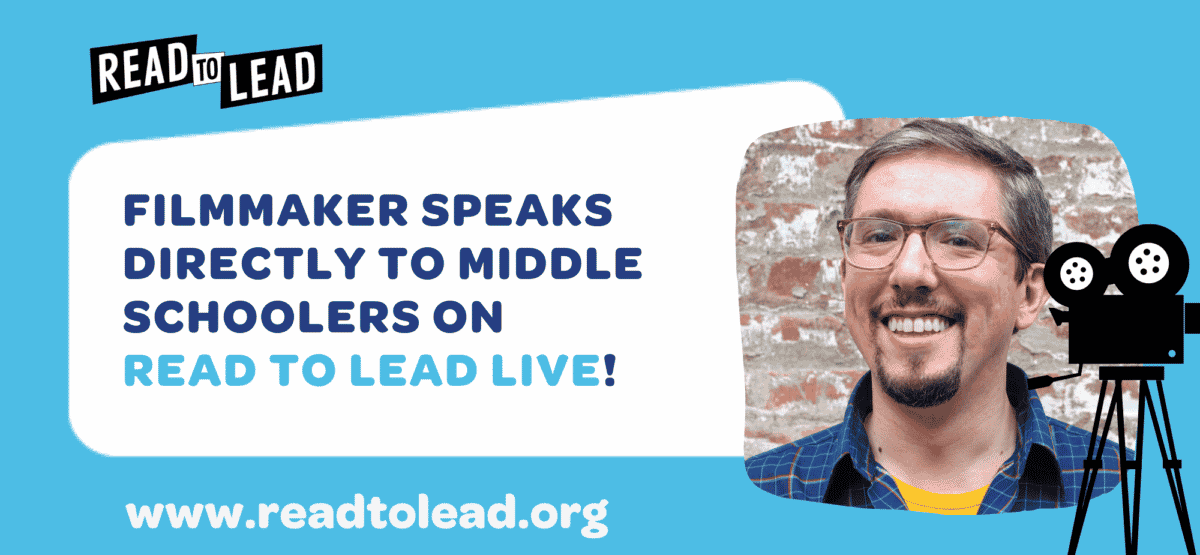
On December 3rd 2021, David Pagano, filmmaker, animator, author, entrepreneur, man of many hats, spoke directly with middle schoolers during Read to Lead: Live! This student-centered webinar chat series gives students a front-row seat into career exploration. Students hear directly from passionate professionals across various industries and from around the country… this time from David himself.
Here are a few of our favorite mic drop moments captured live. 🎤
How did you turn your childhood hobby of making videos with toys into a career?
“When I was a senior in college I made a film. — Might as well do the thing that is most interesting to me, and so I made a LEGO film as my senior thesis.– I had a professor who told me in terms of making films- whatever your idea is, pick something that you’re really going to fall in love with. That really stuck with me. After I graduated, it was a couple of years later that people who worked at the LEGO company saw it. I transitioned somehow from making films with toys in my spare time to making films with toys for the company that makes those toys.”
Can you talk about how it is instrumental to have a team of folks that we trust and rely on for different reasons ?
“None of what I have been able to accomplish was on my own. I can’t overstate how helpful the people in my life have been. — Filmmaking is inherently a collaborative effort.”
What does leadership mean to you?
“Knowing how to admit to mistakes and apologize when necessary. Having a humility and recognizing that not everything is going to go your way sometimes and sort of taking care of the people that you work with.”
How can students show and embrace leadership opportunities now?
“Find your team. Getting involved. There is no age requirement for that. If there is something you know a lot about or if there is something where your time or effort or just your presence can be helpful, seek it out if it’s something that interests you.”
What would you tell your 10-year-old self?
“The word no doesn’t have to be a negative thing, it can be you treating yourself with care.”
Our middle schoolers sent in so many questions for David that we couldn’t get to them all during this one session, so we sent him the most popular unanswered questions and asked if he could put on his author’s hat and write in his responses for you to read…
Where does a student start if they’re interested in getting into the film industry? – Nakul
“For a student in middle school, here’s what I would suggest:
- Watch films. Rent old and new movies, watch TV shows, and keep an eye on commercials and advertisements. Try and seek out things you wouldn’t normally watch, too! If you pay attention, you can begin to pick up on how things are done, and why.
- Read about filmmaking. There are some great books you can check out about film history and technique. I am, of course, partial to “The LEGO Animation Book” but there are tons of others.
- Start making films. To be a filmmaker, you have to make films—it’s pretty much that simple. Get access to a camera (if you don’t already have one) and check out some editing software and tutorials online. A quick web search will pull up many different software packages for Macintosh, Windows, and mobile devices.
Then, just have fun and play around. Be prepared to make lots of bad movies in between the good ones—everyone does this (myself included) and it’s the only way to get better.”
What is your most favorite project you’ve worked on? – Asher
“The latest project I’m proud of is “Little Guys… In Space!”—the biggest, craziest, most complicated film I’ve ever made. Everything in the film is built from LEGO bricks and elements. There are 27 characters across 11 different locations, and the characters alone took a total of 33,286 LEGO pieces to create. It took a crew of 18 people 2,528 hours over the course of 7 1/2 years to complete. And the film is only 3 minutes long.”
What does the day-to-day look like for you? – Unknown
“This is difficult to answer because I work on many different types of projects, and I perform different roles on each. Some days, I’m running the show, wrangling the big-picture details and making sure I’m communicating clearly with my team. Other days, I’m the one receiving direction, and I need to make the thing that I’ve been hired to make as good as it can possibly be.
For me, the best days are when I get to work with my friends on a really complicated or clever stop-motion shot, and we get really excited or can’t stop cracking up at what we’ve made. It’s satisfying, and it helps reassure me that an audience might find it funny and exciting, too. But even the best days can take many forms. I like that there is no one typical day on the job.”
What kinds of skills and personality traits do you need to be a Filmmaker? – Keshav
“This can vary from project to project, but here are a few important ones that come to mind:
- Problem-solving. On every project, there are going to be hiccups and issues that are impossible to anticipate. Bad weather, late shipments, broken cameras, and so forth. As a filmmaker, you need to be good at thinking on your feet to solve these things as they come up.
- Being decisive. This ties in to problem solving a bit, but you need to be good at taking action in order to keep the production moving and meet your deadlines. When other people are counting on you, there’s not much room to waffle back and forth.
- Being a good communicator. Your crew will do their best work when they know exactly what you have in mind, what is expected of them, when the deadlines are, etc.
- Working well with others. Filmmaking is an inherently collaborative art form, and no two artists are alike. Being able to navigate different personality types and work together towards a common goal is key.”
Do you have a favorite app you use? – Unknown
“ At Paganomation, we use a number of computer programs in our productions:
- Dragonframe is used for stop-motion photography. We animate each individual shot as its own series of still photos.
- Adobe After Effects is used to put the stop-motion shots together, and to add special effects.
- Adobe Premiere is used for video editing (for live-action and behind-the-scenes work).
- Adobe Audition is used for sound editing and mixing.
- Logic and GarageBand are used for music scoring.
- Bricklink Studio is used to create building instructions for our LEGO creations. That way, we have the option to rebuild old sets and props for future projects.”
Do you have a favorite LEGO character? – Unknown
“ The LEGO sets of my childhood didn’t really have defined characters in the way that modern LEGO play themes do. That said, I’m very fond of the Captain Redbeard and Johnny Thunder minifigures.”
Do you ever get writer’s block? – Tia’s classroom
“ All the time! I typically solve my writer’s block by doing something entirely unrelated to the project I’m working on. I go off and play a game, exercise, or wash the dishes. (I wrote much of “The LEGO Animation Book” on the train and at the laundromat.)
Focusing on chores or other unrelated activities can provide moments of inspiration, and like many things in life, they’ll come at you when you’re completely unaware.”
Your career has mostly been stop-motion animation and it’s safe to assume that is your preferred medium, is there another medium you like to do, like live-action or digital animation? and why? – Unknown
“ I primarily use LEGO stop-motion because it combines many of my interests:
- physical storytelling and performance
- creating mixed media and assemblage artwork from pre-existing component parts
- surrealism, abstraction, and experimentation
- work that can primarily be done in a small studio or spare room
But for me, it’s less about a specific filmmaking medium and more about checking as many of these boxes as possible.
For example, the live-action documentary I’m directing right now (“The Importance of Being Ernest“) is about Jim Varney, a physical storyteller who played some very surreal characters. I’ll be assembling his story out of interview footage, old film clips, and music. And I’m not yet sure where we’ll be shooting the interviews, but I wouldn’t be surprised if it was in a small studio or spare room.”
And that’s a wrap! Whether you caught this session live or will be watching it on-demand, we hope your students feel inspired by David’s story. Add your name to the waiting list to get up to date news for the next Read to Lead: Live!
About Read to Lead
Read to Lead uses the power of game-based learning to empower middle school students to build literacy, life, and career skills. Teachers can sign up for a free account to get started!


